How To Write Names in Japanese
There are four ways to write names in Japanese, however, only a phonetic translation to katakana is standard. This is how non-Japanese names appear in Japanese newspapers, wikipedia, and in magazines. And katakana has been significantly extended to better accomodate non-Japanese sounds – the others have not. So if you want to be strictly correct, use a phonetic translation to katakana.
With that said, there are reasons one may want to use one of the other three translation methods. One common reason is simply aesthetics. Katakana is naturally angular with straight lines and so it is very limited calligraphically speaking. For example, katakana has no cursive fonts. Because of this I am often asked by women to use hiragana which has naturally flowing and curved lines. And, hiragana is much more suitable for Japanese Calligraphy as all the fonts are available.
Note that in Japan, katakana and hiragana are used by males and females. Though kanji is by far the most commonly used for given names.
And there are a variety of reasons why one might want to use kanji. If you want a seal design, neither of the modern kana has seal script fonts. With kanji the full range of scripts can be used. For more about issues with seal designs see Name Translations and Japanese Seals.
Another reason to use kanji to write names in Japanese is that kanji have meanings. I am reminded of the Denny Crane character from the TV series Boston Legal. In one episode it showed his name in Japanese as デニー鶴 (deni- tsuru) so his first name was translated phonetically to katakana and his last name translated the meaning to kanji using the character 鶴 (read tsuru) meaning “Crane”.

There are four ways to translate names into Japanese:
1. Phonetic Translation – katakana
2. Phonetic Translation – hiragana
3. Phonetic Translation – kanji
4. Literal Translation – kanji
For the phonetic translations, the pronunciation of the name is used to translate the name – not the spelling. For example, the names “Kathy” and “Cathy” are written exactly the same in Japanese. Both are written with the romaji kyashi- which in katakana is キャシー. On the other hand, a name that is spelled the same but pronounced differently will be written differently in Japanese. A good example is the name “Jan”. In America Jan is most often pronounced with a J and in katakana it would be ジャン (jan). In Europe Jan can be pronounced with a Y and in katakana would be written as ヤン (yan). Again, for phonetic translations, the pronunciation of the name is translated, never the spelling.
So if you see a website that does translations of names in Japanese, but does not give the pronunciation of the name, do not trust it. An example of a site not to use for name translations is the Jefferey’s Dictionary site. Jefferey’s is a useful dictionary site, but not for names. As an example, the name Angel has several variations, but the pronunciations are not given. Someone using the site will have no idea which translation to use for how they pronounce their name. Unfortunately, most names in Japanese translation sites have this fundamental flaw.
A good site to use for name translations is StockKanji.com which gives the pronunciation of the name being translated. For example, the name Angel has four different translations because Angel can have very different pronunciations. As a specific example, the entry Angel (ahn-hel, anheru) has the pronunciation ahn-hel and the translation anheru. So StockKanji.com gives the pronunciation of the name and has an easy to understand pronunciation guide. What is better, if a name is not on the site, they are happy to add it at no cost. Just let them know how you pronounce it!
While the phonetic translations use how the name is pronounced, the literal translation uses the meaning of the name. In the Denny Crane example above, the surname Crane is translated to the kanji 鶴 meaning “Crane” and read tsuru. Literal translations are most often used when a name is a word such as Angel, Crane, Joy, Liberty, Violet, and so on.
1. Phonetic Translation (Katakana)
As mentioned in the introduction, the standard way to write non-Japanese names in Japanese is to use katakana. After the end of World War II, as a part of a process to simplify the Japanese language, it was established that all non-Japanese words and names were to be written using katakana.
Katakana 片仮名 is a syllabary with each character representing a syllable (not a letter) and each character has no meaning.
Each katakana character is a simplified form or a part of a kanji (Chinese) character. Katakana’s creation is attributed to the monk scholar Kibi no Makibi (AD 693-755) and was the first syllabary developed. Initially, it was used as a pronunciation aid for Buddhist scriptures. Later katakana was used to write grammatical and inflectional elements just as hiragana is now used. Today katakana is used to write non-Japanese words, names, and technical terms in Japanese.

Along with the basic characters, there are also a few modifiers commonly used with both of the kana.
The sound changes shown in the first chart below use dakuten 濁点 (which looks like a double quotation mark) and handakuten 半濁点 (which looks like the degree symbol – a small circle in the upper right). For example, the symbol ハ is read ha, with the dakuten it becomes バ which is read ba or with the handakuten it becomes パ which is read pa.

There are several modifiers that are small vowels a, e, i, o and u, along with ya, yu, yo and tsu that are collectively called shouji 小字 or small characters.
The ya, yu, and yo have their own name, youon 拗音 and these modify the regular kana as shown in the chart, and may also modify otherkana.
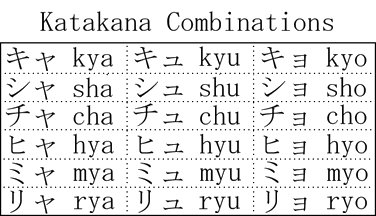
The small tsu also has its own name which is sokuon 促音 and it occurs before kana beginning with k, s, t or p, and acts to double or emphasize the consonant. For example, the name “Duke” is written as dukku in romaji and is デュック in katakana. The small tsu serves to place emphasis on the “k” sound rather than duku デュク, which would not place an emphasis on either syllable. Notice also, in this example the use of a youon which is the small yu which modifies the “de” character and makes it a du sound.
Katakana has many combinations that do not exist within hiragana and kanji. It has the broadest rules as it has been modified to more accurately write non-Japanese words into Japanese. One example of this is the enchou fugou 延長符号 which extends the vowel sound. This corresponds to the dash written in romaji. An example of the enchou fugou is the last character in the name Kelly, written in the sample below.
Note that the enchou fugou orientation changes depending on whether the name is being written horizontally (1) and (2), or vertically (3) and (4). The enchou fugou is the only symbol that changes orientation depending on whether it is being written horizontally or vertically.

Kelly written in katakana (1), (2), and (3) horizontally from left to right (3), (4), and (5) vertically from top to bottom.
Arthur is written in romaji as a-sa-. The reason being that there is no “th” sound so this becomes “sa”. There cannot be two consecutive consonants so the “r” before the “t” is replaced by the elongated vowel symbol. And the final “r” cannot be pronounced alone, so it is also replaced with an elongated vowel. The result is Arthur is アーサー in katakana.
As another example, Japanese does not have the “thy” ending in Kathy and Timothy. These are replaced with shi-. So Kathy is kyashi- キャシー and Timothy is timoshi- ティモシー.
As a final example, Brian is buraian which may be seem counter-intuitive. Names are written in Japanese by how they are pronounced, not by how they are spelled. Because the “r” is after a consonant, it is normally pronounced. The “B” alone becomes the syllable “bu”. Brian in katakana is ブライアン.
Recently katakana has been further modified to better render non-Japanese pronunciations. For example, Japanese does not have a “v” sound and so historically everything with a “v” were written with a “b”. For example, the name Steve was written as suti-bu or スティーブ. Today it is written suti-vu or スティーヴ where u ウ is modified to vu ヴ.
Katakana and Japanese Seals
One problem with katakana is also its strength: the upside is the lines are simple and angular and can be written quickly, the downside is this leaves little room for artistry. This makes katakana easy to write, but the simple and angular lines do not have a cursive or even most semi-cursive fonts. Thus much of Japanese Calligraphy’s expression simply cannot be used with katakana.
Requiring that katakana be used for all non-Japanese names present problems. One common issue is that “Seal Script” (tensho) should be used for seals. This script is complex and curving which makes it more difficult to forge. Because of this feature, seals have been written using Seal Scripts for thousands of years.
The problem is that Seal Scripts predate the creation of katakana by several thousand years and is only defined for use with kanji. This contradiction means that a rule is going to have to be broken. And once we begin breaking rules, the best we can do is look to precedent on how to proceed. This is where things get interesting.
To avoid confusion with what I have just stated, I would like to clarify one point about seals. In Japan, there are two types of seals. One is called inkan, this is used for everyday purposes. The other is called tenkoku (lit. “Tensho Carving”) and is used for legal purposes. If my name were Yamada, I could go down the street to a stationary store and buy a pre-made inkan for Yamada. Of course, all of the other Yamada’s in the area could do the same. This seal, this inkan, could be used for all daily purposes as the Japanese equivalent of a signature. However, for legal purposes, such as for opening a bank account, this seal could not be used. One would need to have a unique and complex seal that is registered with the government and for this purpose, the tenkoku seal must be used.
To illustrate this point I compare the styles below. These are different seals for Sairei which is my professional name in Japan. Figure (1) is how the seal would look using katakana, (2) is a regular font that would be suitable for an inkan seal, and (3) is a Seal Script design which would be common design for a tenkoku seal.

Seal designs for sairei
How Can Initials Be Translated?
As Japanese is a language of syllables, it is awkward to translate initials. The method used is to translate how the letters are pronounced. For example, the letter “A” is エー which has the romaji e-. This also means that the single letter “W” takes five symbols to write in Japanese. “W” has the romaji daburyu- and is written ダブリュー.

As an example, IBM’s legal name in Japan is partly written as アイ・ビー・エム (ai bi- emu).
2. Phonetic Translation (Hiragana)
Hiragana 平仮名 is attributed to the Buddhist priest Kuukai (AD 774-835) and was famously adopted by the poetesses of the Heian period (794-1185) who did not wish to use the angular, and to them masculine looking, katakana. Hiragana, also called 女手 onnade or “feminine hand”, is a flowing, soft syllabary that is particularly well-suited for the semi-cursive and cursive fonts.
Today hiragana is used to write grammatical elements, adjective and verb inflection, and native words for which kanji either does not exist or is not commonly used.
In Japan, male and female given names can be written in hiragana so there is not a hard gender distinction. For non-Japanese names where the norm is to use katakana, however, it becomes an aesthetic choice. As hiragana can be much more feminine, women will sometimes prefer hiragana to write their given name.
Previously, Kathy was shown in katakana as キャシー. One may, however, prefer to use the hiragana version きゃしい.
But do keep in mind that katakana has been modified so that it is particularly well-suited to write non-Japanese names and words. Standard hiragana does not have the same modifications.
For example, the enchou fugou is not supposed to be used with hiragana (though one does see it). With Kathy kyashii this is not an issue as many Japanese words treat the duplicate vowel as a vowel extension. For example, the word tanoshii the duplicate “i” is an elongation. And while this convention always works for Japanese words, it often falls apart for non-Japanese words. How would the Hawaiian place name “Ka’a’awa” be written? In katakana it is easy to show that each “a” is pronounced individually, so it is kaaava カアアヴァ. In hiragana it would be ambiguous and, in fact, one does not see it written in hiragana.
From time to time one will see an obsolete method for extending vowels in hiragana which often adds the character “fu” to denote elongation. An example would be that ヌー would be written as ぬふ in hiragana. This should not be used and has its own issues. An example of the confusion that could result would be the name Ralph with the romaji rarufu which would be らるふ.
Names that used the enchou fugou character in katakana would double the vowel in hiragana. This is demonstrated in the sample below which shows how Kelly would be written in hiragana as kerii けりい.
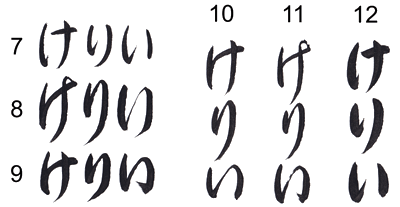
Kelly written in hiragana (7), (8), and (9) horizontally from left to right (10), (11), and (12) vertically from top to bottom.

As with katakana, hiragana also has sound changes called dakuten (which looks like a double quotation mark) and handakuten (which looks like degree symbol – a small circle in the upper right corner).
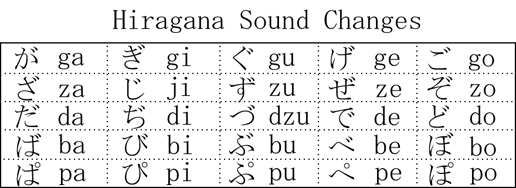
Hiragana also uses the small characters or shouji 小字 a, e, i, o and u, along with ya, yu, yo, and tsu.

3. Phonetic Translation (Kanji)
A phonetic translation to kanji is known as 当て字 ateji. There is a long tradition of using phonetic translations to kanji that goes all the way back to when Chinese was first adapted to write Japanese.

Kelly written phonetically in kanji meaning “Respect and Reason”.
Notice with kanji we can use all of the calligraphy fonts. Here we show block, semi-cursive and cursive samples.
A Phonetic translation maintains the pronunciation of the name but assigns a new meaning to the name. In general, phonetic translations work best when the name has one to three syllables.
An excellent example is the name Oscar which means “spear of the gods” from Old English. In Japanese Oscar would be osuka- which can be translated phonetically to kanji as osuka using the characters 雄火 meaning “man of fire”.
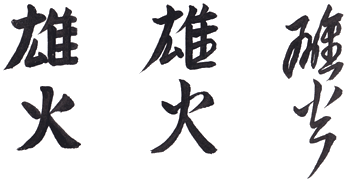
Oscar written phonetically in kanji meaning “man of fire”
Note that the vowel elongation symbol (enchou fugou) is never used with kanji. So the common solution is to simply omit elongated vowels. Though because this is a non-standard translation method, there are no hard rules. For balance, or if a particularly meaningful kanji can be found then it can be used to elongate the vowel by duplicating it.
An example of a name that does not work well as a phonetic translation to kanji is Adriana which has four syllables and in Romaji is eidorianna. At best this can be translated to four kanji which is quite long for a name. It is also difficult to find a consistent and meaningful translation for such a long name.
When a name translates to over three kanji, one should consider a nickname or an abbreviation. For Adriana the nickname Adrie would be eidori in romaji and would be two or three kanji which is more suitable for a phonetic translation.
As a further example, Timothy would be teimoshi- which is rather long at three characters, but Tim could be translated as teimu which for a gardener meaning “Garden Dream” or 底夢 would work nicely.
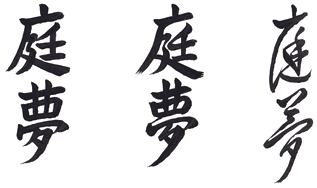
Tim written phonetically in kanji meaning “garden dream”
Katakana has been modified over the years specifically to make it easier to write non-Japanese names and words into Japanese. The result has been that there are standard ways to translate names to katakana that cannot be translated to kanji. This is because Katakana has evolved to represent sounds that are simply not found in the Japanese language.
One example, as previously mentioned, is the elongated vowel symbol for which there is no equivalent in kanji. This is why one will see osuka- as a romaji representation for a katakana translation but will see osuka for a kanji translation.
One common problem with a phonetic translation to kanji is that there are several syllables which exist in katakana but which have no kanji equivolent. For example, the name Jennifer is written jenifa- in romaji and the katakana is ジェニファー. The problem is there are no kanji with the read “je” or “fa”. In katakana to create a “je” sound the “ji” and “e” symbols are combined. Similarly, for the “fa” sound the “fu” and “a” symbols are combined. With kanji one is forced to write all these elements and so it becomes “jienifua”.
“jienifua” would require five kanji characters to write. This is very long for a first name (most Japanese first and names are two characters each). A solution as mentioned previously might be to use the nickname Jenny which would be three kanji. For example, one could choose ji 慈 meaning “mercy”, e 恵 meaning “grace (blessing)” and ni 仁 meaning “benevolence”.
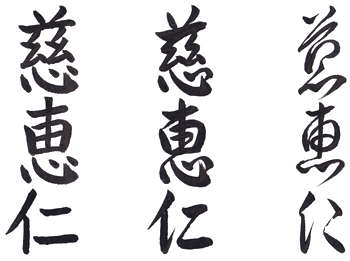
Jenny written phonetically in kanji meaning “mercy, grace, benevolence”
Another difficulty with a phonetic translation to kanji can be the fact that there may be a poor selection of kanji that have the right sound. That is, one or more kanji may exist with the right sound, but the meanings are less than acceptable. Two examples that are common in non-Japanese names, but have very few options are the single syllables he in Helen and ra as in Randy. With he the solution is to substitute hei which sounds similar and offers some kanji with appropriate meanings.
As a further example, Petra is a beautiful sounding and very feminine name. Unfortunately, there is no kanji that has a natural pe sound. One gets a pe sound when he is preceded by an n as in the name kanpei 寛平 or after a small tsu as in the name ippei 一平. The solution is to use a kanji for he, but as there are no good kanji with the reading he we substitute the similar sounding hei.
So for Petra we have the romaji petora though we use kanji with the readings hei 平 meaning “gentle, peaceful” and tora 虎 meaning “tiger”.

Petra written phonetically in kanji meaning “gentle tiger”
The problem with using a phonetic translation to kanji is that most probably no one will correctly read the name. Remember the kanji hei 平 used above. If you click on the link you can count that there are over 10 different readings for this one character. It can be hei, but also hyou, hira, taira, tara, hachi, hi, hitoshi, he, or hen. With katakana and hiragana this problem does not exist – each character has only one reading. But kanji can have an overwelming number of possible readings.
The fact that a kanji can have several different readings means that even the Japanese themselves have to deal with this issue for their own names. Their solution is to use a name card that has not only the kanji for their names but also the proper reading! So while people may not be able to immediately read your name when phonetically translated to kanji, if you explain it, then they will get it.
4. Literal Translation (Kanji)
With a literal translation, the meaning of the name is translated. Many times a parent gives a name to a child that has a special meaning. For example, “Angel” because one’s son or daughter is like an angel. A literal translation preserves this meaning, but not necessarily the pronunciation.
I say not necessarily because one does see Japanese writing their name in kanji but using the English pronunciation. Angel is written 天使 which is read tenshi. But one also finds the name 天使 read enjeru, that is, pronounced with a phonetic translation of the English name Angel. As a further example, the name Rose is used in Japanese and the kanji is 薔薇 which is read bara. However, some Japanese will write the name 薔薇 but insist the reading is “ro-zu” (Rose). See Rose for an example.
This is one reason why StockKanji.com includes several designs with a phonetic translation to kana and a literal translation to kanji. For specific examples, see Angel, Crane, Joy, Liberty, and Violet.
We mentioned above that the name Jan can be pronounced using a “J” or a “Y” sound and that the translation would change depending on the pronunciation. With a literal translation, even though the name is pronounced differently, the meaning of the name is the same, and so the translation will be the same. Therefore, a literal translation is the same for both names and this happens to be “God is Gracious” which we translate as 神恵 shinkei For some examples see Jan in Japanese.
There are several possibilities for the meaning of Kelly. I have used the meaning from the Gaelic ceallach, meaning “war”. The translation then becomes Warrior, or 戦士 senshi in Japanese.
An excellent website to find the original meaning of a name is Behind the Name – The Etymology and History of First Names.

Kelly written literally in kanji meaning “warrior” read senshi
The name Liberty is ribati in romaji and リバティ in katakana. A phonetic translation to kanji can be done which would be three characters. However, the original meaning of the name “liberty” would be lost. Another option is to translate the meaning to 自由 which is read as jiyuu and means “freedom; liberty”.
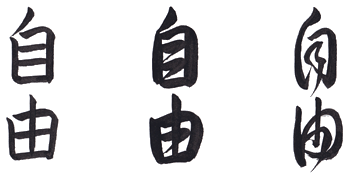
Liberty written literally in kanji read jiyuu
Other examples of names that are particularly suitable for a literal translation to Japanese are:
|
Literal Translations to kanji |
||
| Amber | kohaku | 琥珀 |
| Fawn | kojika | 子鹿 |
| Forrest | shinrin | 森林 |
| Hunter | kariudo | 狩人 |
| Ruby | kougyoku | 紅玉 |
| Star | hoshi | 星 |
Another example of when one might select a literal translation may be for artistic reasons. The name Joy is a short and beautiful name. This can be translated phonetically as 上位 is read joui and means superior. Or it can be translated literally as 喜 meaning “Joy” and read yorokobi.
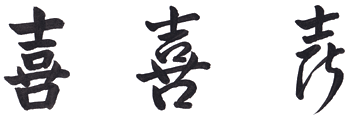
Joy in kanji read yorokobi
From the example one can see a visual similarity between Joy in English and in kanji.
There are several cases where literal translations cannot be done. The most common case is when a name’s meaning is
not known. The meaning of several ancient names have been lost and for these, there is no recourse. In the beginning of this article, I used Adriana as an example. Adriana means “From Adria” which is a place name whose original meaning has been lost and so the meaning cannot be translated.
Another case when names cannot be translated is when the word or concept is either too foreign to Japanese or may not be appropriate. Calvin for some reason means Bald which some may not consider worthy of preserving in a name translation. Another example is Brody which means Ditch.
As examples of names that are foreign are Lyndon (from the Linden tree) and Ashley (from the Ash tree) which have scientific names in Japanese, but do not have common words.
For a literal translation to Japanese one must first determine the appropriate meaning of the name. This is a study in and of itself and there are several excellent books and on-line resources. Once one has the meaning then a good Japanese dictionary is a must. The better the dictionary the more likely the meaning will be unambiguous and in common usage.
Summary
To translate a name to Japanese all that is needed is the Kana charts, a kanji dictionary, or a Japanese dictionary. With these tools, a suitable translation can be found. However, if you do the translation yourself it is always a good idea to get feedback from a native speaker that knows their stuff. Most will not be well versed in the ins and out of translating names, however.
As an example of what can go wrong, two cases come to mind. One person wanted Casanova translated as Lover. Using a literal translation from a dictionary, the version of lover that this person selected was aijin which means lover as in a mistress. Certainly, this was not the intended meaning.
In a second example the person wanted a name that meant heaven. To do this they had selected an archaic reading of the modern kanji 乾. And as this ancient meaning is no longer taught, Japanese who read the translation read it as kawaku meaning “to dry out”. If you check the link, you will see that indeed one of the meanings is “heaven” … but this meaning is archaic.
A good site to use for name translations is StockKanji.com which gives the pronunciation of the name being translated and it gives options for the name in both katakana and hiragana and, when possible, the literal translation to kanji along with a translation to kana. And if the name is not on the website they will add it at no charge, just ask, and be sure to let them know the pronunciation!
